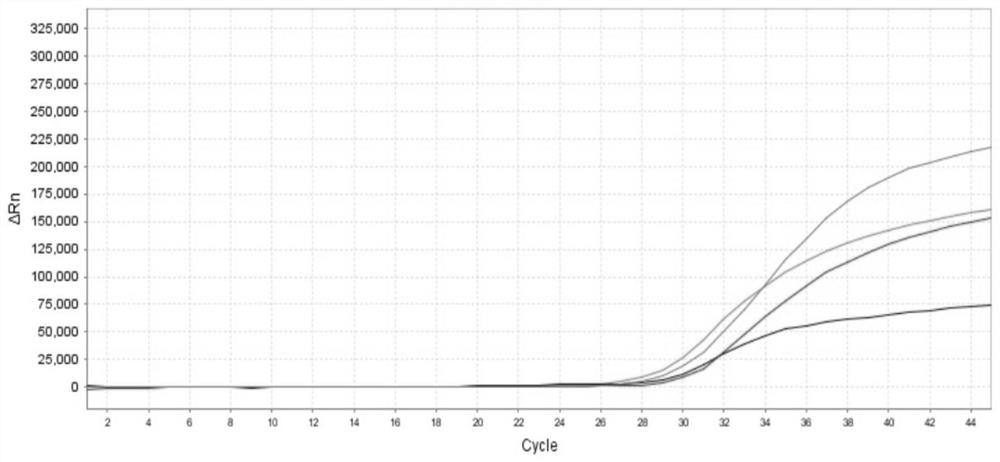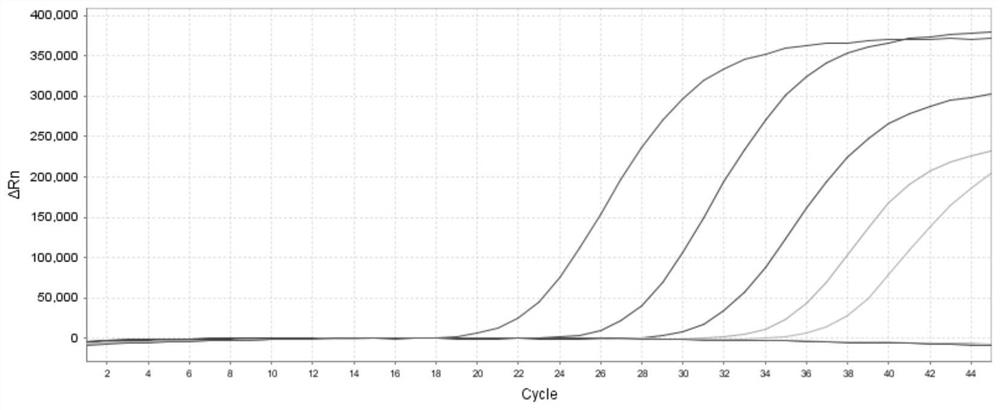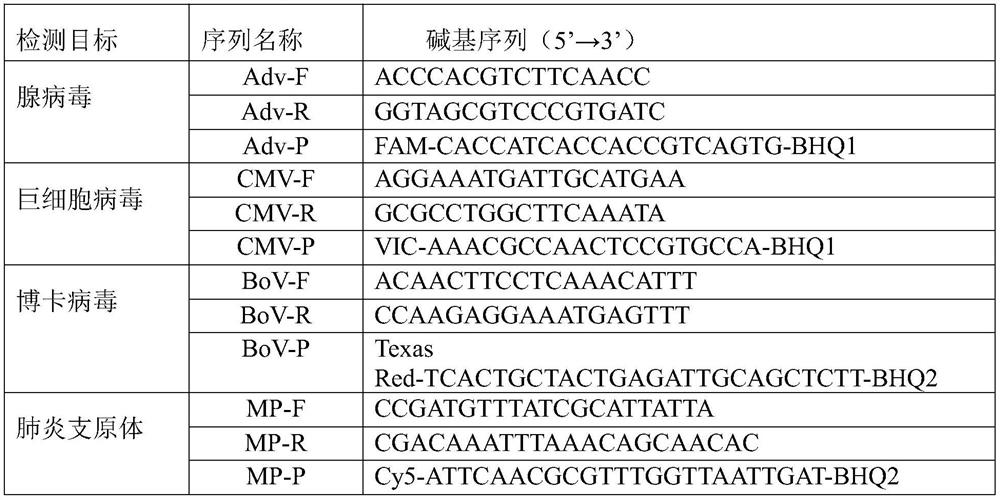Multiplex fluorescence PCR kit, method and application for detecting respiratory tract pathogens
A multiple fluorescence and kit technology, applied in the field of biomedicine, can solve the problems of narrow detection range of respiratory virus nucleic acid detection kits, limited detection throughput by instruments, limited use range, etc., so as to shorten the detection time and reduce the detection cost. , high sensitivity and specificity
- Summary
- Abstract
- Description
- Claims
- Application Information
AI Technical Summary
Problems solved by technology
Method used
Image
Examples
Embodiment 1
[0051] This example provides a multiple real-time PCR detection kit for detecting adenovirus, cytomegalovirus, bocavirus and mycoplasma pneumoniae, including probes for detecting adenovirus and specific amplification of adenovirus target genes Primer pair for detection of cytomegalovirus and primer pair for specific amplification of cytomegalovirus target gene, probe for detection of Boca virus and primer pair for specific amplification of Boca virus target gene, Probe for detecting Mycoplasma pneumoniae and primer pair for specific amplification of Mycoplasma pneumoniae target gene, MgCl 2 , dNTPs Mixture, Taq DNA polymerase, plasmid mixture containing the target gene and nuclease-free water;
[0052] This embodiment provides a method for detecting bronchial lavage fluid using the above kit:
[0053] 1. Extract the nucleic acid of bronchial lavage fluid from clinical samples, and obtain the samples to be tested after purification;
[0054] 2. Prepare reaction system
[005...
Embodiment 2
[0070] This embodiment is the same as Example 1, except that the clinical samples, the primers and probe concentrations amplified by each pathogenic microorganism, the system component concentration of the amplification reaction, and the conditions of the amplification reaction are different from Example 1: this implementation The clinical sample taken for example is sputum, the primer concentration of each pathogenic microorganism amplification is 0.1 μ M, and the probe concentration is 50 nM; the MgCl in the reaction buffer described in the amplification reaction system 2 The working concentration of TaqDNA polymerase is 2mM, the working concentration of dNTPs Mixture is 350μM, and the working concentration of TaqDNA polymerase is 4U / μL. The amplification conditions are shown in the following table:
[0071]
[0072] In this example, the CT value of cytomegalovirus was ≤40, the detection results of negative control, adenovirus, boca virus and mycoplasma pneumoniae had no C...
Embodiment 3
[0074] This embodiment is the same as Example 1, except that the clinical samples, the primers and probe concentrations amplified by each pathogenic microorganism, the concentration of components in the amplification reaction system and the conditions of the amplification reaction are different from Example 1: this implementation The clinical sample that example takes is alveolar lavage fluid, and the primer concentration that each pathogenic microorganism is amplified is 1.0 μ M, and probe concentration is 250 nM; 2 The working concentration of Taq DNA polymerase is 4mM, the working concentration of dNTPs Mixture is 450μM, and the working concentration of Taq DNA polymerase is 6U / μL; the amplification conditions are shown in the following table:
[0075]
[0076] In this example, the CT value of Boca virus was ≤40, the test results of negative control, adenovirus, Boca virus and Mycoplasma pneumoniae had no CT value, and the CT value of each channel detection target of the ...
PUM
 Login to View More
Login to View More Abstract
Description
Claims
Application Information
 Login to View More
Login to View More - R&D
- Intellectual Property
- Life Sciences
- Materials
- Tech Scout
- Unparalleled Data Quality
- Higher Quality Content
- 60% Fewer Hallucinations
Browse by: Latest US Patents, China's latest patents, Technical Efficacy Thesaurus, Application Domain, Technology Topic, Popular Technical Reports.
© 2025 PatSnap. All rights reserved.Legal|Privacy policy|Modern Slavery Act Transparency Statement|Sitemap|About US| Contact US: help@patsnap.com



